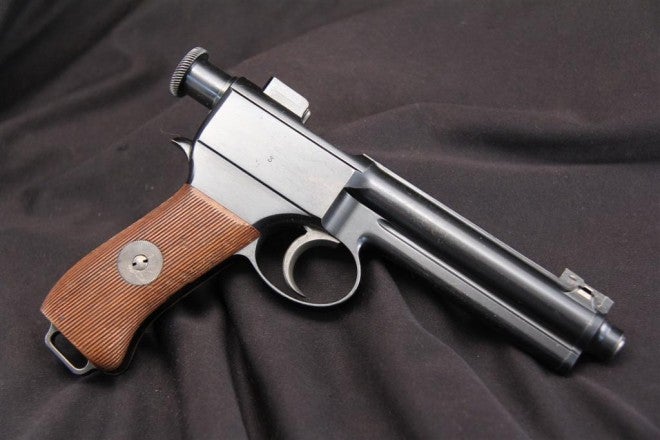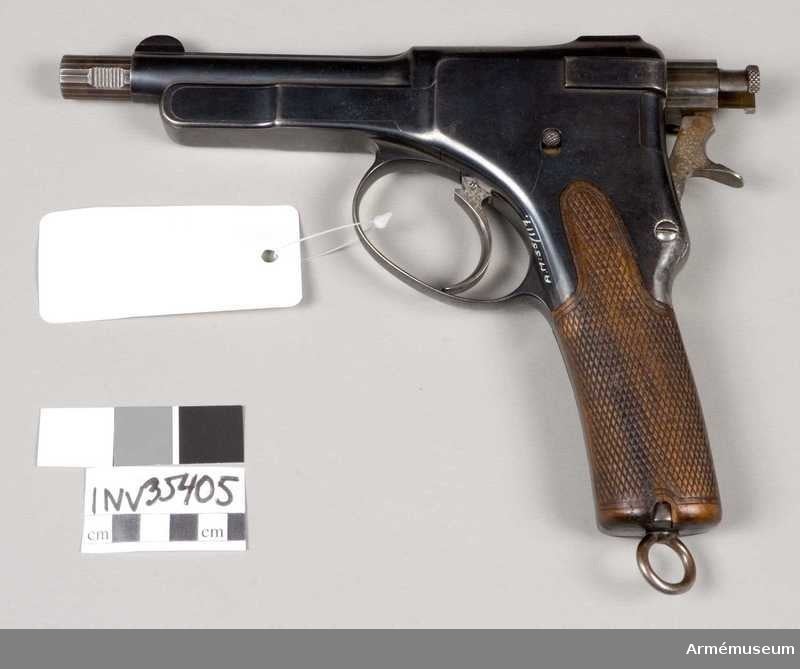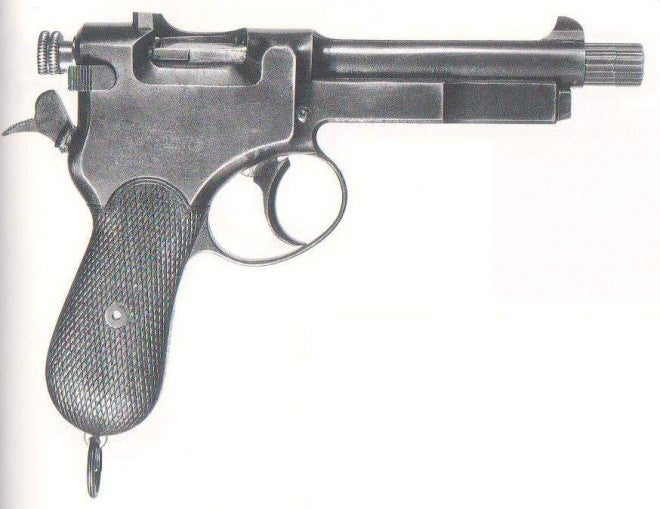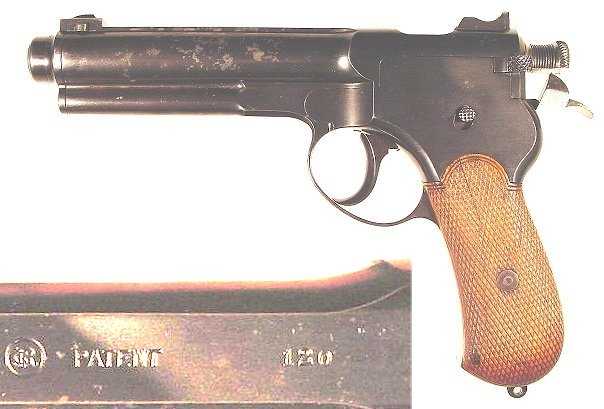The Editor Writes: This week’s Friday Field Strip Video/Article combo is on the fascinating 1907 Roth-Steyr. Watch Alex’s video above then read Nathaniel’s article below …
Austrian cavalrymen in World War I each went into battle with three handguns, all identical Steyr-made semiautomatics that fed 8mm rounds via stripper clips, two located in a holster at the base of the horse’s neck, and another in a hip holster at the rider’s side. These guns were, when they were adopted, the most advanced service firearm in the world, and their designer, a Czech inventor from Bohemia named Karel Krnka, could arguably be called the “John Browning of the Austro-Hungarian Empire.”

The M.7 Roth-Steyr, designed by Karel Krnka, is a unique and innovative pistol that ranks near the top of the list of best early automatic service handguns. Image source: lsbauctions.com
Karel (alternately spelled “Karl” and “Karol”) Krnka was, like Browning, himself the son of a genius firearms inventor, the talented Silvester Krnka, who designed in the 1860s a breechloading conversion of the 1857 Six-Line Rifle-Musket for the Imperial Russian Army. Karel would follow in his father’s footsteps, beginning work in the 1880s on new patterns of repeating breechloading rifles, a straight-pull of 1887 designed with his father, and a bolt-action of 1890; the latter of which used a novel charger design that successfully worked around Mauser’s patent for the stripper clip. Krnka’s rifles failed to be adopted, despite being trialled in the home country and in Romania and Russia, but both designs were innovative, if overcomplicated.
In the early 1890s, Karel turned his attention to handguns, beginning with a manually-operated 1891 design with a 6-8 round rotary magazine. By 1895, Krnka had developed, with the help of Austrian ammunition magnate and industrialist Georg Roth, a self-loading handgun, one of the world’s first. This was the somewhat ungainly 1895 Roth-Krnka, which, although it was the earliest incarnation of the mechanism that would be used in the eventual 1907 Roth-Steyr, had some major flaws, chiefly in ergonomics. The design would be improved, however, with the 1897 and 1899 pistols, which together serve as a sort of intermediate step to the design’s final form. This final iteration would be realized as the 1904 Roth-Krnka, which was tested by the Austro-Hungarian Army, and, with some modifications (particularly the elimination of the manual safety), was adopted in 1906 by the cavalry of the Kaiserliche und Koenigliche Armee of the Austro-Hungarian Empire in the 1907 as the Repetierpistole M.7, thereby becoming the first semi-automatic pistol in the world to achieve adoption by a major military power.
In 1900, Roth arranged production with J.P. Sauer & Sohn in Suhl of a smaller version of the Krnka design, chambered for a proprietary 7.65x17mm caliber. Even though the 7.65mm Roth-Sauer was less powerful than the dimensionally similar .32 ACP, the smaller gun retained the complex and difficult to manufacture short-recoil action and locking mechanism of its larger cousin.
A final variation of the Krnka design was realized in 1908, with a prototype developed in a .45 caliber round (possibly the .45 ACP introduced with the Colt 1905), probably intended for testing by the US Army.
The M.7 was produced by both Österreichische Waffenfabriksgesellschaft in Steyr, Austria, and FEG in Budapest, Hungary, with 59,334 and 38,213 made at each, respectively. It served with the Austro-Hungarian Empire through the First World War, and after the war was fielded by Yugoslavia, Hungary, and Austria. Further, both the Polish and the Italians received M.7 handguns as part of reparations for the war, with some 17,000 of them going to the former. These guns served at least until the Nazi invasion of 1939, and the type as a whole would serve at least until 1942.

The Roth-Steyr loaded with a unique stripper clip, which used an built-in slider to smoothly push the cartridges into the action. It held 10 rounds in its internal magazine, of 8mm Roth-Steyr ammunition that is approximately equivalent to 7.65 Parabellum in power. For the time, this was quite a lot of firepower. This image was borrowed from a great article written in Italian by TFB friend Pierangelo Tendas for all4shooters.com.
Small Arms Review has an excellent article written by the inimitable Jean Huon on the nuts and bolts of the Roth-Steyr, excerpts of which are reproduced below:
This weapon has no detachable magazine, but a fixed magazine located in the grip, loaded with a stripper clip, like a Mauser rifle. To unload the magazine it is necessary to open the bolt and press the cartridge stop.
The frame is also used as the grip. It is provided with a cover plate on the left side. This plate is embedded in the frame at the front in top and is kept in place when the left grip is assembled. On the inner face is assembled the bolt hold open latch. The magazine is composed of a parallelogram-shaped case with a tubular extension at its base, mounting the following spring. On the left face of this magazine is the button that retracts the cartridge stop to unload the weapon.
The grips are furnished with two obliquely striated wood plates that on the left is fixed by a traditional screw; that of right-hand side is held in place by a screw removable by a screwdriver with prongs, which at the same time keeps in place a disc on which is inscribed the number and the name of the unit to which the gun is issued, although this is not on all examples.
The upper part of the frame is machined with two superimposed cylindrical elements, the top one receives the bolt and the barrel and the bottom one the recoil spring. One can only marvel at the complexity of the parts and the precision of machining when computer controlled machining did not exist. At the rear are the ejection port and a clip guide.
The trigger mechanism is located on the left side of the frame and comprises the trigger, cam and sear. They pivot on pins machined into the frame, except the cam whose pin is built-up on the second model.
The slide is a cylinder, hollowed at the front to receive the barrel. The rear part holds the firing pin and its spring. The posterior end is threaded to receive a plug. The barrel is cylindrical, and has two guide ribs at the front and at the back two locking lugs. Its calibre is 8mm (.32) and it has four grooves with the right hand twist. The slide is held to the frame by a plug locked by a cross pin before the front sight. The recoil spring is assembled with a minimum of tolerance in its housing and does not have a guide, but only a stop at the back. The sights are composed of a V notch, milled in the clip guide and a front sight dovetailed into a stud that also receives the cross pin for the slide plug.
And on the gun’s ammunition:
This cartridge, standard in the Austro-Hungarian Army, was adopted in 1907. It remained in service a long time after the adoption of the M 1912 Steyr pistol, and could also be found during WW II. Its manufacture was mainly concentrated around the German and Austrian cartridge factories. It was listed on a Fiocchi catalog some years ago, but this did not mean it was available… The rimless cylindrical case measures 18.7 mm long. The Austrian service cartridge has a cylindro-ogival bullet weighting 7.20 grams (112 grains), with a lead core and a cupronickel jacket. The velocity was 320 m/s (1,052 fps). The Fiocchi Italian cartridge, fires a 7.30 grams (114 grains) gilding metal jacketed bullet at 330 m/s (1,085 fps).
The Roth-Steyr, like another, more famous Austrian handgun, used an innovative half-cocked double-action striker-fired mechanism, allowing it to be safely carried without fear of accidental discharge, at least in theory. For cavalry who at the time used handguns as primary weapons (and who might be liable to drop a pistol from 7 or 8 feet off the ground), this was a considerable benefit. In the early part of the 20th Century, safety features like this were not yet common in automatic handguns, and the Roth-Steyr’s very large sear engagement surface and out of battery safety made it one of the safest automatic pistols of the period. Krnka designed this system 80 years before Gaston Glock designed his polymer wondernine, and over 30 years before Walther would popularize the DA/SA mechanism with the PPK, making his design truly a pistol ahead of its time.
A final note about Karel Krnka: Earlier, I suggested for him the title “the John Browning of the Austro-Hungarian Empire”, which is not as far fetched as it seems. A quick look at his patent history is its own elaboration:
Breechface-operated rifle, 1909
Recoil-operated pistol and rifle, 1899
Breechface-operated mechanism, 1913
Roth-Steyr 1904/1907 Patent, 1900
Manually-operated pistol with rotary magazine, 1888
Extractor and ejector for bolt guns, 1891
Improvement to breechface-operated gun
Quite as prolific and as innately talented as the Master from Ogden he may not be, but his designs by and large are inventive, sound, and above all early, and so it’s certainly eyebrow-raising that Krnka isn’t better known than he is.
 Your Privacy Choices
Your Privacy Choices


